Our next destination was atop the Chamundi Hills (one of the eight most sacred hills of South India). The hills of Chamundi are named after the goddess Chamundeshwari (deity of the Royal Family). The main Chamundi Hill which carries the Chamundeshwari Temple atop is approximately 3489 ft. above sea level and located to the east of the city of Mysore. This temple is dedicated to Mysore’s titular deity, Chamundeshwari (Durga), and made of solid gold. A tutelary (also tutelar) is a deity or spirit who is a guardian, patron or protector of a particular place, geographic feature, person, lineage, nation, culture or occupation.

This hill was very high and steep (I was getting car sick), and when we got to the top, it was bustling with energy and excitement. We had to park quite far from the temple and walk the rest of the way. There were many people selling offerings to take inside the temple.
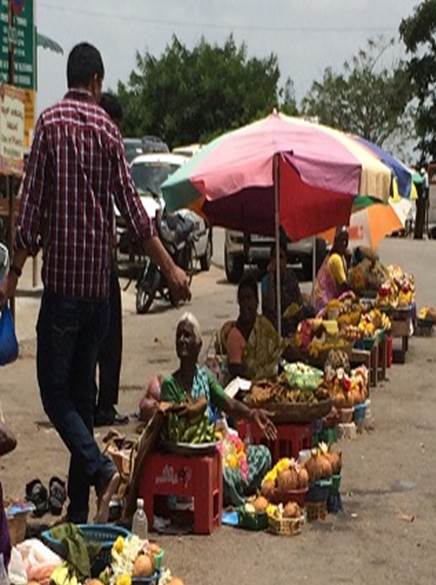
I just love the look on this lady’s face, priceless. I am sure she is thinking “How come you don’t want my stuff?”
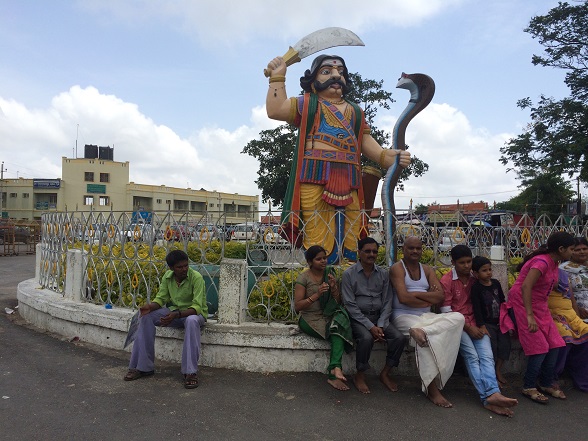
Along the way we witnessed a large statue of Mahishasura with a sword in his right hand and a cobra in the left. According to legend, the demon Mahishasura (king of the city that is currently known as Mysore) was killed by the Goddess Chamundeshwari (also Chamundi) after a fierce battle.
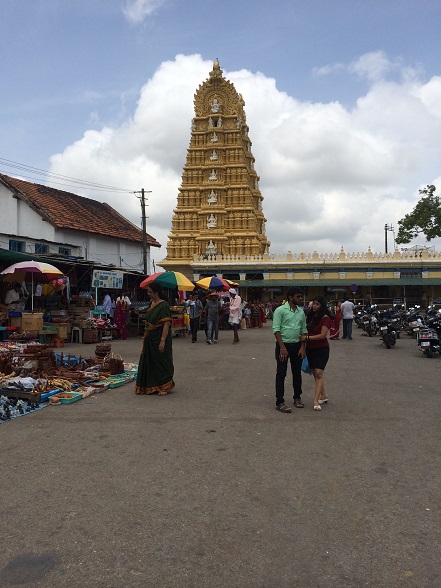
Once on top of the hill we could see the beautiful temple as well as a great view of the city of Mysore.
The Chamundeshwari temple has been patronized for centuries by the rulers of Mysore. It was renovated during the time of Krishnaraja Wodeyar III (1827). It has a fine quadrangular structure. Within the temple’s sanctum stands a sculpted depiction the Goddess Chamundeshwari, wearing a garland of skulls. You are not allowed to take pictures inside the temple, but here is a picuture of what this Goddess looks like.
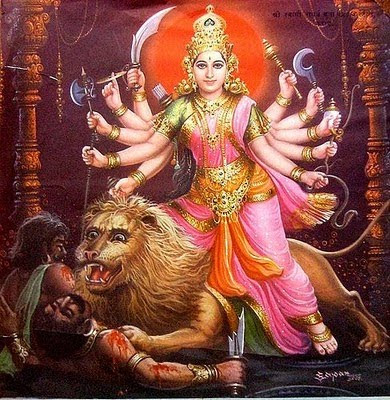
Seated, her right heel is pressed against the lowest of the seven chakras. This cross-legged yogic posture echoes that of the Lord Shiva. It is believed that this powerful yogic posture, if mastered, enables one to have an added dimensional view of the universe. Since the early days of the Maharajas of Mysore, it has been customary that the idol of Goddess Chamundi is carried upon a ceremonially-decorated elephant as part of the celebrations in the annual Dusshera festival.
Narender, my guide, says that you will always see newly married couples, new babies, new cars and motorcycles up close to the temple as the priest will come out and bless them. That is really cool. We did see many newly married couples, but unfortunately I did not get any pictures of them.
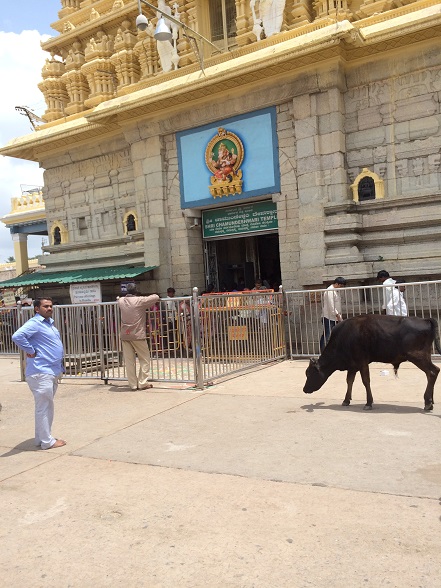
In 1659 Dodda Devaraja Wodeyar built 1000 steps to the top of Chamundi’s main hill.
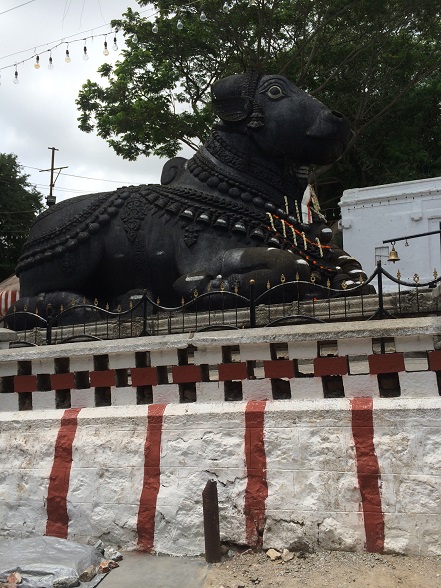
He also built at step number 700, a huge Nandi, Lord Shivas bull. This is one of the largest Nandi’s in India, at 16ft tall and 25 ft. in length. This ancient stairway’s lower 600 steps are significantly steeper than those above.
After this we lunched at “The Olive Garden”. Not quite like the Olive Gardens here in the states. This was a beautiful outdoor pavillion. We had a nice relaxing lunch of curry and rice before hitting the road again.
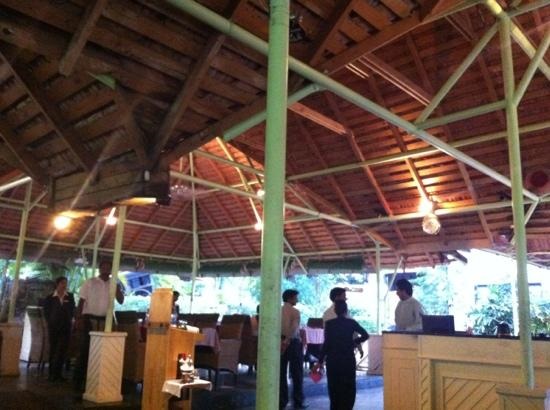
I didn’t have any idea what a treat I was going to have when Narender said he wanted to show me The Keshava Temple. The Keshava Temple is located in Somanathapura town in Mysore district. It is about 30 minutes outside Mysore. Known for its prosperity during the heydays, the town was named after the same general. Somanathapura is the last of the ornate agrahara settlements of the Hoysalas.
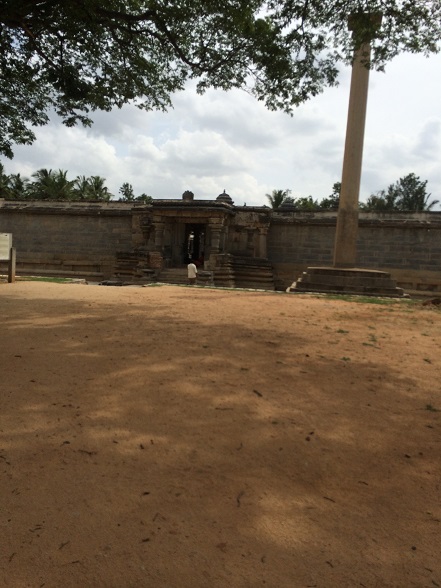
When we drove up, I could hardly believe my eyes. I have never seen anything like this temple, so old, so unique, and the closer I got; the more grateful I was to have the privilege of seeing something so magnificent. It was like being in an Indiana Jones movie!
It was like looking at a beautifully wrapped present, only to open to find inside a gift so much more beautiful. I walked through the entrance and realized what I originally saw was just the exterior “fort”. The temple was inside!
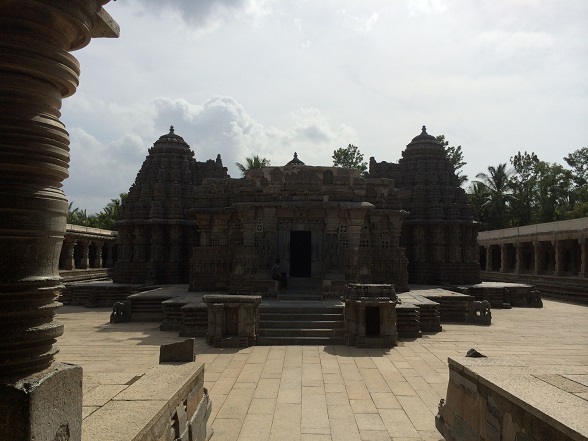
The Keshava temple was built in A.D. 1268 by Somanatha Dandanayaka, an illustrious General of the Hoysala king Narasimha III (1254-1291 A.D). It is situated on the left bank of the Cauvery River.
This is a temple honoring Krishna in his 3 forms, Keshava, Venugopala and Janardhana. It is not a “living temple” because the main Keshava was stolen and the Venugopala and Janardhana were damaged. Because it is not “living”, there is no priest on site. However, that does not diminish the value of this temple.
This temple is a perfect example of the Hoysala style of architecture. It stands on a raised platform in the center of a spacious enclosure having sixty four cells. You can see in this picture the cells that surround the main temple. Each of these cells at one time had statues in them. The main Temple, a three celled structure (trikatu temple) consists of three Garbha Ghihas (the innermost sanctums of a Hindu temple where resides the murti of the primary deity of the temple where only the priest or pujari is allowed.) This structure also has three Antaralas, small antechambers or foyers between the garbhagriha (shrine) and the mandapa (a pillared outdoor hall or pavilion for public rituals) and a Navarang which I believe is a central, pillared hallway.
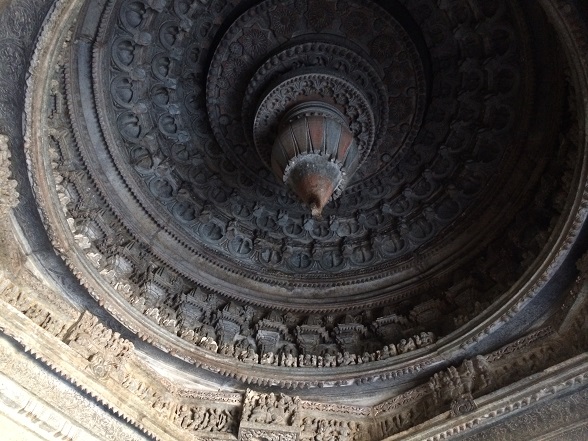
It was really dark inside so taking pictures was next to impossible, however I was able to get a picture of the ceiling in the entrance. If you look closely, you can see little people scenes carved in the stone. The ceilings in the 3 temples were all different, with lotus’s, banana leaves and other designs.

The ceilings and door jambs leading to the sanctum sanctorium are exquisitely carved. There are ornately carved examples of magnificent craftsmanship depicting Vishnu, Lakshmi, Saraswati, Ganesha, Ratisanmatha and Mahishasura.
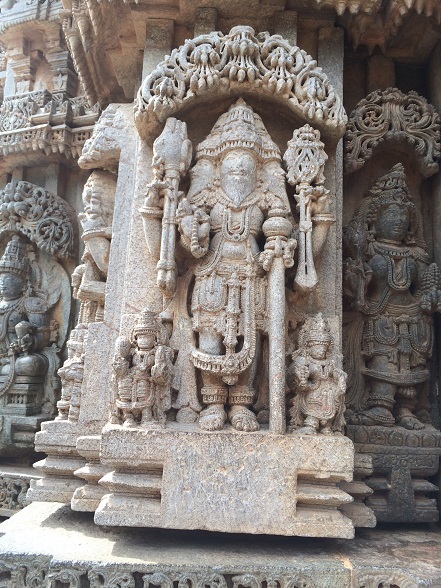
The affluence of the age is testified by the people and activities portrayed in the sculptures. Members of the royal family riding in richly-decorated chariots, soldiers and commoners commuting in horse, elephant, and camel-drawn vehicles, gods and goddesses entertained by dancers and musicians, hunters armed with bows and arrows heading towards the forest along with dogs are all portrayed through the sculptures.
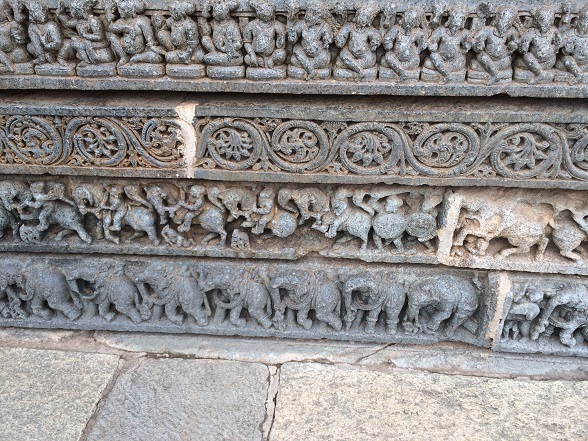
The basement of the outer wall is highly ornamented with friezes of elephants representing the strength needed to hold up the building, the next layer are horses representing the speed of which the building would be built while continuing to fight battles. Then there was a level of scrolls, representing the ancient texts. Then images of small of figures, some women, some warriors.
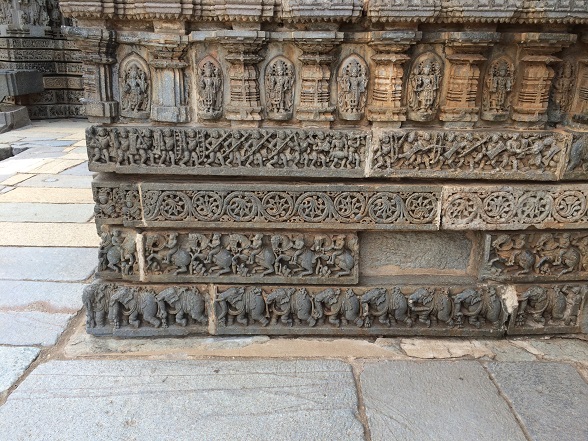
Gods and Goddess and their attendants adorn the walls in the next layer up separted by intricately carved columns.
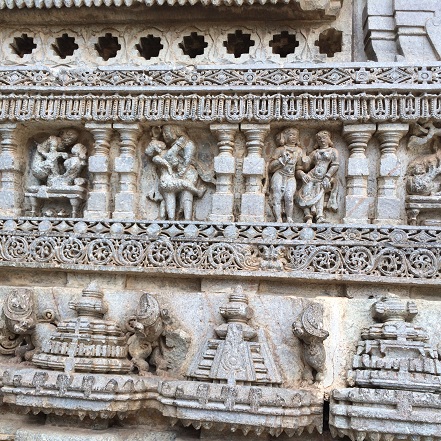
As you continued up the outside walls, there were elephants and then some kama sutra figures. The intricacy of the sculptures was mindboggling. You could see the jewelry on the figures.
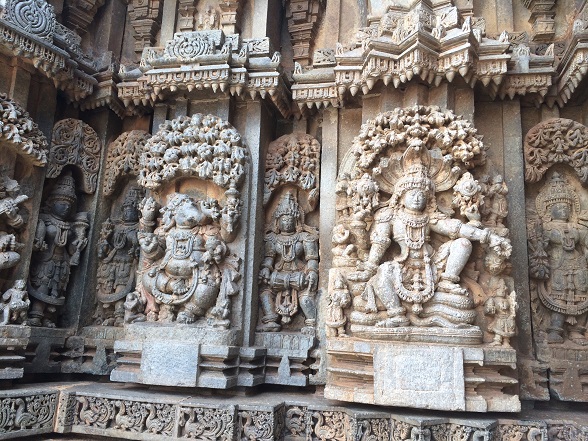
Here is Ganesh, the elephant god and remover of obstacles, and Vishnu, sitting on his snake. Look at the base of this sculpture, a little row of geese.
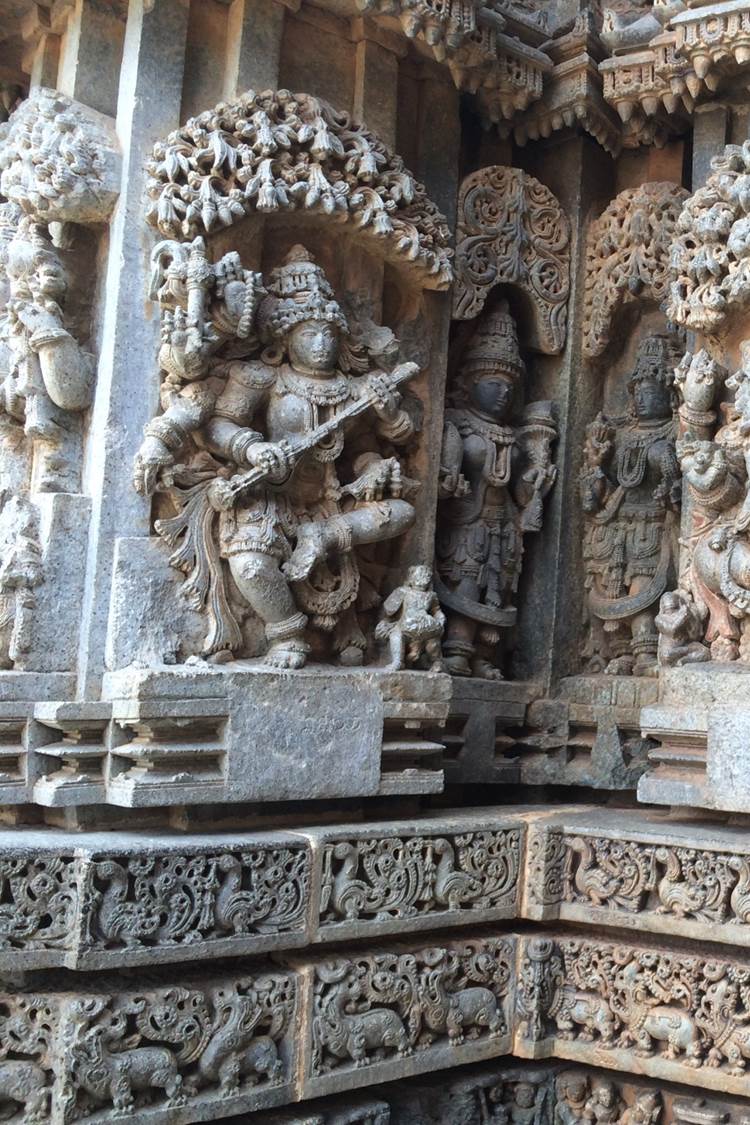
The entire outside of the building is carved with these statues. All different, all beautifully done. Each one a masterpiece.
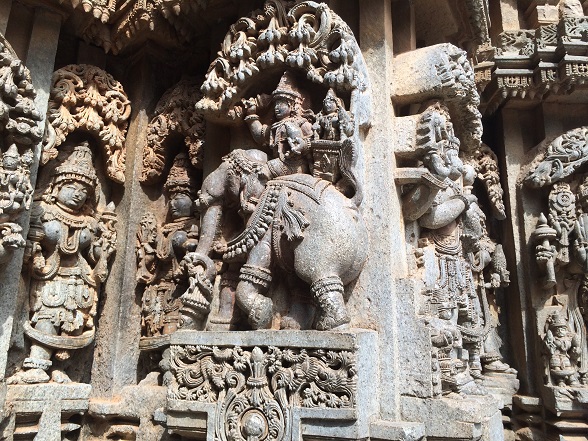
Narender said that it took all kinds of artists, sculptors, silversmiths, goldsmiths, ivory-carvers, cooks, carpenters, wood carvers, soldiers and others to build this temple.
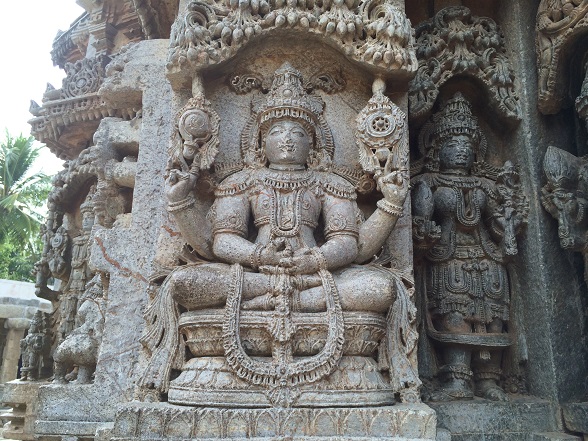
Imagine the demand for artists to work on massive temple projects in the past.
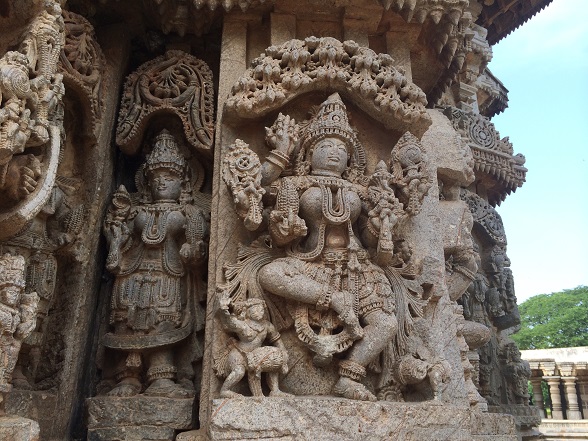
The artists documented their works of art by inscribing their names, the guilds they belonged, the place from where they hailed and above all the titles they bore Many of these artists could even hardly spell their names correctly, which is evident from the conspicuous errors.
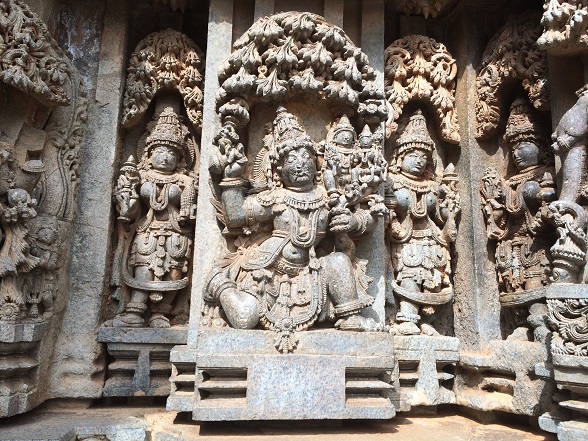
Mallithama’s name appears in 40 places and mostly to do with the ornamentation of the temple. It appears he had no rivals in the art.
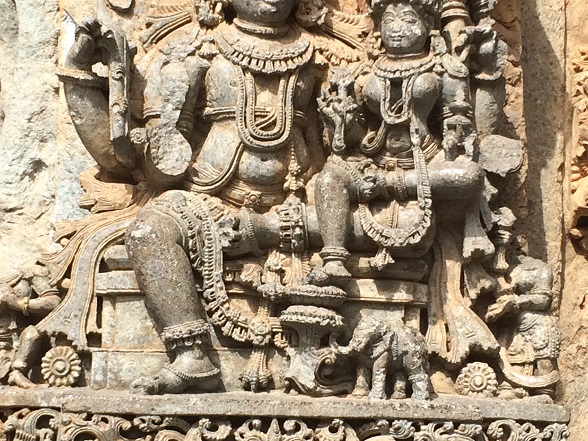
Here is my favorite, the Goddess Laksmi sits on her husband Vishnu’s lap. She has her foot on a lotus flower, but the lotus flower not strong enough to hold up the Goddess’s foot, gets the elephant to help by holding up the lotus.
There are inscriptions on a slab standing at the entrance, inside the temple, dated from 1269 to 1550 A.D. that detail construction of the temple and grants made to it.
As we left the temple, I was overwhelmingly moved by the artistry and sheer talent of the scultors who created this magnificent monument to the Divine.
